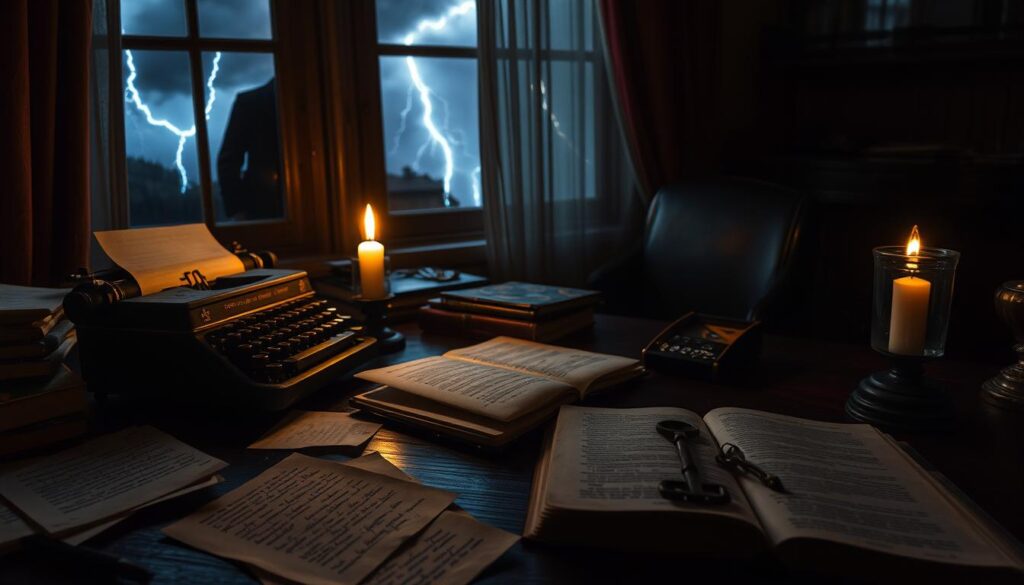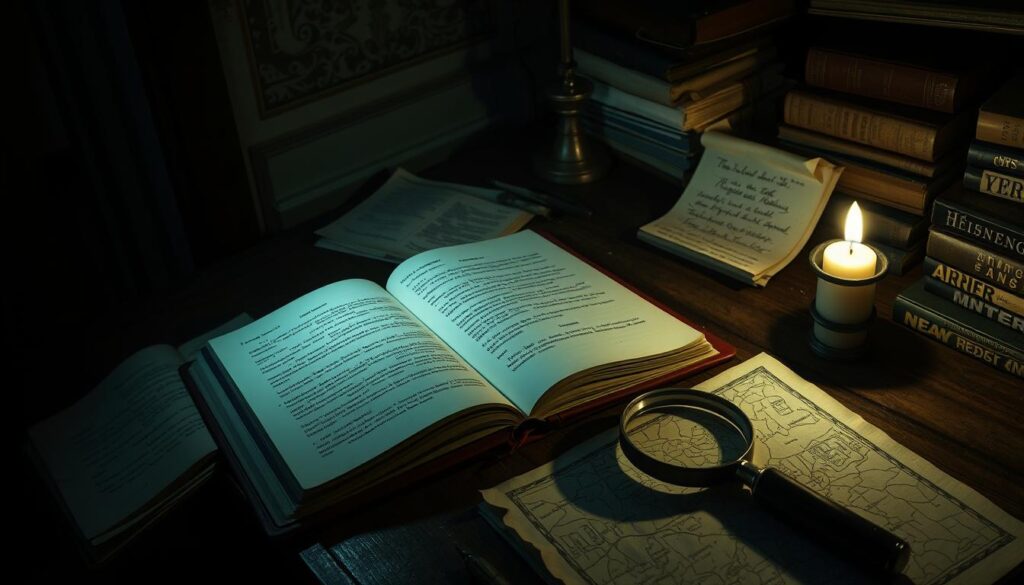Welcome to the world of mystery story writing! If you want to write a mystery that grabs readers, you’re in the right spot. Mystery stories have a special power to keep readers guessing and eager for more. To write a great mystery, you need to know the key elements and understand who you’re writing for.
In this section, we’ll dive into what makes a mystery story captivating. We’ll also give you a sneak peek at the valuable tips coming up. Get ready to learn the secrets of creating mysteries that readers will remember!

Key Takeaways
- Discover the essential elements of a compelling mystery.
- Learn effective writing techniques that engage audiences.
- Understand the importance of knowing your readers.
- Explore various mystery genres and trends.
- Set the stage for mastering the craft of mystery writing.
The Essence of a Great Mystery
To create a great mystery, you need to know its key parts. First, find the elements that grab your readers’ attention. These include a solid plot, interesting characters, and a setting that pulls you in. It’s also key to have a clear goal for the main character and a big question that drives the story.
Understanding the Core Elements of Mystery
The mystery genre has a few main things that make it work. Let’s dive into what’s important:
- Compelling Plot: A plot full of surprises keeps readers hooked.
- Intriguing Characters: Characters with depth make readers care about them.
- Defined Setting: A detailed setting adds depth to the story and makes it more enjoyable.
- Clear Goal: A main character with a clear goal gives meaning to their actions.
Building Suspense and Intrigue
Suspense is key to keeping readers interested. Knowing how to build tension can make your story better. Here are some ways to do it:
- Strategic Pacing: Changing the pace of events can build excitement and anticipation.
- Effective Cliffhangers: Ending chapters with questions makes readers want to keep reading.
- Selective Information: Keeping some details hidden can make readers curious and try to solve the mystery.
These methods help create the suspense that makes mysteries so engaging. By controlling how readers feel and what they expect, you can keep them fully engaged.
| Element | Description | Importance |
|---|---|---|
| Plot | A sequence of events and actions that create a storyline. | Drives the narrative and retains reader interest. |
| Characters | Individuals that populate the story, each with unique traits. | Creates emotional connection between the reader and the story. |
| Setting | The time and place where the story unfolds. | Establishes context and mood, enriching the reader’s experience. |
Developing Strong Characters
Character development is key in making mystery stories engaging. Strong characters grab readers’ attention and keep them hooked. They make the story feel real and personal.
Let’s look at what makes characters stand out. This includes relatable heroes, complex villains, and supporting characters that add depth to the story.
Creating Relatable Protagonists
Your main character should have traits that readers can identify with. Give them strengths, weaknesses, and goals. This makes them relatable and interesting.
It’s also important to show how your character grows. Watch them face challenges and learn from them. This makes the story more engaging and personal.
Crafting Complex Antagonists
Antagonists should be more than just villains. They should have their own story and reasons for acting. This makes them more interesting and complex.
By showing their struggles and weaknesses, you can make them more relatable. This adds a layer of depth to the story and makes the battle between good and evil more compelling.
Supporting Characters that Enhance the Story
Supporting characters are just as important as the main ones. They help shape the story and impact the hero’s journey. Their interactions create important relationships that drive the plot forward.
Having a diverse cast of characters adds depth to your story. It creates a richer and more believable world. Good supporting characters make the story feel complete and real.

Mystery Story Writing Techniques
Mastering mystery writing is all about keeping readers guessing. Using red herrings and placing clues well are key. These tricks help create suspenseful plots.
Setting Up Red Herrings
Red herrings are a must in mystery writing. They lead readers astray, making the story more complex. It’s important to use them right, so they don’t confuse your readers.
Utilizing Clues Effectively
Writing clues needs finesse. They should be smart but not too easy to spot. This lets readers solve the mystery with the characters. Clues should blend into the story naturally, keeping readers hooked.
Building Tension through Pacing
Pacing is key to keeping the story tense. Quick moments add urgency, while slower ones build emotion. The right pace keeps readers eager to find out what’s next.

| Technique | Purpose | Examples |
|---|---|---|
| Red Herrings | Create misdirection | False suspects, misleading timelines |
| Clue Placement | Engage readers | Incorporating clues in character dialogues |
| Pacing | Build tension | Controlling chapter length and cliffhangers |
World-Building in Mystery Stories
Creating a great mystery story starts with world-building. A good setting is key for an engaging story. It lets readers feel the mystery unfolding. It also makes the suspense even more thrilling.
Establishing an Engaging Setting
Building a rich setting means thinking about geography, culture, and history. These elements shape your story. You might pick a foggy village or a busy city full of secrets.
Each setting brings its own challenges and clues. They help move the story along.
Creating a Believable Atmosphere
A believable atmosphere makes the story more real. It’s not just about what you see. It’s about what you hear, smell, and feel too.
For example, a creaking floor can make you tense. The smell of damp earth can add to the story’s mood. When you get these details right, readers feel like they’re part of the story.
| World-Building Elements | Impact on Mystery |
|---|---|
| Geographical Features | Affect plot movement and character decisions |
| Cultural Background | Shapes characters’ motivations and conflicts |
| Historical Context | Adds layers of intrigue through backstory |
| Atmospheric Details | Enhances emotional engagement and suspense |
By drawing readers into a detailed setting, you make your story unforgettable. It stays with them long after they finish reading.
Plot Development Strategies
Creating a gripping mystery story needs a good grasp of plot development. Understanding the story arc structure is key. It lays the groundwork for your tale. Each part, like exposition and climax, is important for building a strong mystery.
Mastering these elements helps craft stories that grab and hold your audience’s attention.
Structuring Your Story Arc
The story arc has essential phases that guide readers through the mystery. Start with exposition, introducing characters and setting. Then, the rising action builds suspense and intrigue.
The climax is the peak of tension, where key mysteries are revealed. After, the falling action deals with the aftermath, leading to the resolution. A clear structure keeps readers excited and eager for more.
Using Twists and Revelations
Plot twists are vital for keeping readers engaged. Well-timed twists surprise and lead to unexpected conclusions. Use foreshadowing to hint at revelations without spoiling the surprise.
Strategic placement of twists keeps readers guessing, making them re-examine clues and relationships. This keeps them hooked as they solve the mystery.
The Role of Dialogue and Description
Mystery stories need both authentic dialogue and descriptive language to be engaging. Character conversations help drive the plot and show off their personalities. Realistic dialogue creates tension and connects characters with readers.
Writing Authentic Dialogue
To write real dialogue, try these tips:
- Listen to real conversations to get the speech rhythm right.
- Define each character’s voice; it should match their background and personality.
- Use subtext; let characters say one thing but mean another for depth.
- Incorporate interruptions, as they make conversations feel more real.
Painting Vivid Scenes with Descriptive Language
Descriptive language is key for setting scenes. It pulls readers into your world. To make scenes vivid, use sensory details for sights, sounds, and smells. Here are some tips:
- Utilize metaphors and similes for powerful imagery that sticks with readers.
- Engage all five senses to bring scenes to life; describe what a character tastes or feels.
- Show emotions through description; for example, a stormy setting can show a character’s turmoil.
Combining real dialogue with descriptive language makes your story better. It draws readers into your mystery, making it more engaging.
| Technique | Description | Impact on Story |
|---|---|---|
| Authentic Dialogue | Realistic and relatable character conversation. | Enhances character development and engagement. |
| Descriptive Language | Use of vivid imagery and sensory details. | Immerses readers and strengthens visual storytelling. |
Conclusion
In this summary of mystery writing, we’ve looked at key elements for creating engaging stories. We’ve talked about adding depth to your narrative and making characters that readers love. Each part is important for your writing journey.
Remember, pacing, red herrings, and real dialogue are key. They make your story better and keep readers hooked. This is your chance to show off your creativity and make your story unique.
Your mystery writing journey is just starting. Use the tips from this article and try new things. With these tips, you can write stories that keep readers guessing until the end.
FAQ
What are the core elements of a compelling mystery story?
A good mystery story has a strong plot, interesting characters, and a clear setting. It also has a central question that keeps the story moving. Knowing these basics helps you grab your readers’ attention.
How can I build suspense and intrigue in my mystery writing?
Use techniques like pacing, cliffhangers, and selective information to create suspense. This makes readers curious and eager to keep reading.
What strategies should I use to develop strong characters?
Create relatable heroes with clear goals and growth. Also, make your villains complex with their own stories. Supporting characters should add to the main story and depth.
How do I effectively incorporate red herrings and clues in my mystery story?
Red herrings should mislead but not too much. Use clues that feel right in the story. This lets readers solve the mystery with your characters.
What is the importance of world-building in mystery stories?
Good world-building makes the mystery richer. It creates a setting that affects the story’s mood. This draws readers into the world of the story.
What are the key strategies for effective plot development?
A well-structured story arc is key. Include exposition, rising action, climax, and resolution. Adding twists keeps the story exciting and satisfying.
How can I write authentic dialogue and vivid descriptions?
Focus on dialogue that shows character and moves the plot. Use descriptive language to bring scenes to life. This makes the story more immersive for readers.




